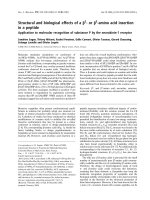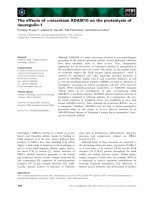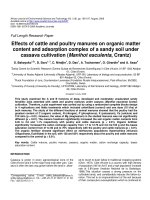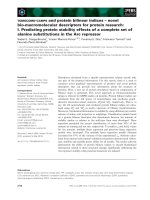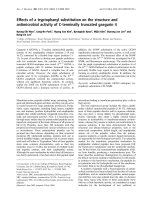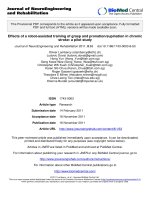Effects of compost, mycorrhiza, manure and fertilizer on some physical properties of a Chromoxerert soil
Bạn đang xem bản rút gọn của tài liệu. Xem và tải ngay bản đầy đủ của tài liệu tại đây (313.31 KB, 9 trang )
Soil & Tillage Research 78 (2004) 59–67
Effects of compost, mycorrhiza, manure and fertilizer
on some physical properties of a Chromoxerert soil
I. Celik a,∗ , I. Ortas a , S. Kilic b
a
b
Department of Soil Science, Faculty of Agriculture, Cukurova University, Adana, Turkey
Department of Soil Science, Faculty of Agriculture, Mustafa Kemal University, Antakya, Turkey
Received 20 September 2002; received in revised form 27 January 2004; accepted 2 February 2004
Abstract
Addition of organic materials of various origins to soil has been one of the most common rehabilitation practices to improve soil physical properties. Mycorrhiza has been known to play a significant role in forming stable soil aggregates. In
this study, a 5-year field experiment was conducted to explore the role of mycorrhizal inoculation and organic fertilizers on
the alteration of physical properties of a semi-arid Mediterranean soil (Entic Chromoxerert, Arik clay-loam soil). From 1995
to 1999, wheat (Triticum aestivum L.), pepper (Capsicum annuum L.), maize (Zea mays L.) and wheat were sequentially
planted with one of five fertilizers: (1) control, (2) inorganic (160–26–83 kg N–P–K ha−1 ), (3) compost at 25 t ha−1 , (4) farm
manure at 25 t ha−1 and (5) mycorrhiza-inoculated compost at 10 t ha−1 . Soil physical properties were significantly affected
by organic fertilizers. For soil depths of 0–15 and 15–30 cm, mean weight diameter (MWD) was highest under the manure
treatment while total porosity and saturated hydraulic conductivity were highest under the compost treatment. For a soil depth
of 0–15 cm, the compost and manure-treated plots significantly decreased soil bulk density and increased soil organic matter
concentration compared with other treatments. Compost and manure treatments increased available water content (AWC) of
soils by 86 and 56%, respectively. The effect of inorganic fertilizer treatment on most soil physical properties was insignificant
(P > 0.05) compared with the control. Mycorrhizal inoculation + compost was more effective in improving soil physical
properties than the inorganic treatment. Organic fertilizer sources were shown to have major positive effects on soil physical
properties.
© 2004 Elsevier B.V. All rights reserved.
Keywords: Soil aggregation; Soil physical properties; Soil organic matter; Compost; Manure; Mineral fertilization; Mycorrhiza
1. Introduction
It has been shown that addition of organic matter improved soil properties such as aggregation,
water-holding capacity, hydraulic conductivity, bulk
density, the degree of compaction, fertility and resistance to water and wind erosion (Carter and Stewart,
∗ Corresponding author. Tel.: +90-322-338-6084;
fax: +90-322-338-6643.
E-mail address: (I. Celik).
1996; Zebarth et al., 1999; Franzluebbers, 2002).
Generally, crop residues, manures, turfs, forest under
story leaf falls, and compost from organic wastes
have been used to increase soil organic matter (SOM)
content and accordingly to improve soil physical
properties in croplands (Stratton et al., 1995).
Generally, fertile soils have a relatively high structure stability index and percentage. Improvement in
soil aggregation by organic matter addition positively
affects the germination of seeds, and the growth and
development of plant roots and shoots (Van Noordwijk
0167-1987/$ – see front matter © 2004 Elsevier B.V. All rights reserved.
doi:10.1016/j.still.2004.02.012
60
I. Celik et al. / Soil & Tillage Research 78 (2004) 59–67
et al., 1993). Plant roots, root hair, mycorrhizae and
fungal hyphae play a significant role by binding
agents within and between aggregates (Tisdall, 1994;
Ortas, 2002). In the rhizosphere, mycorrhizal hyphae may contribute further to the aggregating effect
as they grow into small pores and bind soil particles together (Miller and Jastrow, 1990). Sutton and
Sheppard (1976) found that aggregation of sand-dune
soil by mycorrhiza treatment was five times greater
than that of sandy soil particles without mycorrhiza
treatment. Bearden and Petersen (2000) reported
that mycorrhiza played a significant role in the formation of aggregates and aggregate stability of a
Vertisol.
Recent studies have shown that soil particles are
bound not only by mycorrhiza hyphae but also by
mycorrhizal polysaccharide (Tisdall, 1994; Smith
and Read, 1997). Water-stable soil aggregates were
correlated positively with root and arbiscular mycorrhizae soil mycelium development (Bethlenfalvay
et al., 1999). Mycorrhiza have also benefited soil
ecology, soil rehabilitation, and erosion control by
stimulating soil aggregation (Abbott et al., 1992;
Ortas, 2002). Recently, a strong correlation was shown
between aggregate stability and glomalin, a glycoprotein produced by hyphae of arbuscular mycorrhizal
fungi (Wright and Upadhyaya, 1998). Schreiner
and Bethlenfalvay (1995) reviewed the effect of
mycorrhizal fungi on aggregate formation and soil
structure.
Since soil management systems influence soil physical fertility, it is important to determine the effect
of long-term organic and inorganic fertilizer amendments on soil physical properties such as aggregation,
porosity and water-holding capacity. In the related literature, effects of separately applied organic matter on
soil properties were studied. In this study, combined
effects of organic manure and mycorrhiza were investigated. Therefore, the objective of this study was
to assess if long-term organic fertilization and myc-
orrhizal inoculation could improve some soil physical
properties under semi-arid Mediterranean soil conditions.
2. Materials and methods
2.1. Study area
The field study was carried out at the Agricultural
Experimental Station of Çukurova University, Adana,
in southern Turkey, where the prevailing climate is
Mediterranean with a long-term mean annual temperature of 18–19 ◦ C. During the experiment from 1995
to 1999 the annual mean temperature was 18.6 ◦ C, and
relative humidity was 66%. Long-term mean annual
precipitation is around 650 mm, about 75% of which
falls during the winter and spring (November–May),
but during the experiment from 1995 to 1999 the annual mean precipitation was 622 mm. Long-term mean
annual potential evapotranspiration is 1500 mm per
year (Aydin and Huwe, 1993).
The experiment was carried out on an Arik
clay-loam soil, which was classified as an Entic
Chromoxerert (Soil Survey Staff, 1994). Some selected properties of the soil at the beginning of the
experiment in 1995 are given in Table 1.
2.2. Preparation of compost and
mycorrhizal inoculum
Compost used in the experiment was prepared according to the method described by Rynk (1992). The
compost was made from a mixture of grasses, stubbles and plant leaves with equal ratio for 8 months
under atmospheric conditions. The inoculum (mixture
of sand + soil + spores + hyphae) was produced in
pots using sorghum (Sorghum bicolor L.) host plants
(Ortas, 1996). Before sowing the sorghum seeds, a
cocktail mycorrhizal inoculum was mixed with the
Table 1
Selected physical and chemical properties of soil
Soil depth (cm)
Clay (%)
Silt (%)
Sand (%)
Organic matter (%)
CaCO3 (%)
pH (1:2.5)
Total salt (%)
0–15
15–30
36
38
35
37
29
25
1.6
1.4
30
33
7.6
7.8
0.06
0.06
I. Celik et al. / Soil & Tillage Research 78 (2004) 59–67
compost material. Approximately 1000 spores/plant
were calculated for the total number of plants per
hectare.
2.3. Field experiment
The study was conducted in 15 plots in a
randomized-block design with three replications, during 1995–1999. The plot dimensions were 10 m wide
and 20 m long.
The treatments were (1) control (CO); (2)
traditional N–P–K fertilizers (160 kg N ha−1 as
(NH4 )2 SO4 , 83 kg K ha−1 as K2 SO4 , and 26 kg P ha−1
as 3Ca(H2 PO4 )2 ·H2 O) (F); (3) compost at 25 t ha−1
(C25); (4) farm manure (cattle) at 25 t ha−1 (M25)
and (5) mycorrhiza-inoculated compost at 10 t ha−1
(C10+MZ). The sequence of annual crops since 1995
was wheat (Triticum aestivum L.), pepper (Capsicum
annuum L.), maize (Zea mays L.) and wheat.
For each plot, a moldboard plough to 30 cm depth
was used for soil tillage after each harvesting time. Annually, the organic fertilizers (M25, C25, C10 + MZ)
were homogenously spread out on the soil surface
in September and incorporated with a discharrow to
a depth of 12–15 cm. Field cultivation to a depth of
20–22 cm was made to prepare a smooth seedbed before sowing. Similar procedures were followed for the
control and fertilizer plots.
2.4. Soil sampling and analyses
Before soil sampling, each plot was divided into
two equal subplots. Disturbed and undisturbed soil
samples were taken from the center of each subplot
at depths of 0–15 and 15–30 cm in June 1999, immediately after the harvest of the last wheat crop. For
aggregate analysis, approximately 3 kg disturbed soil
samples were taken. The samples were air-dried
and sieved through 4 and 8 mm sieves. Undisturbed
61
soil samples were taken by using a steel cylinder
of 100 cm3 volume (5 cm in diameter, and 5 cm in
height). Bulk density, total porosity, saturated hydraulic conductivity and field capacity were determined from undisturbed soil samples. Organic matter
concentration and wilting point were determined using disturbed soil samples sieved through a 2 mm
meshed utensil. Dry bulk density was measured by the
core method (Blake and Hartge, 1986), porosity was
determined according to Danielson and Sutherland
(1986), saturated hydraulic conductivity was determined by the falling-head method (Klute and Dirksen,
1986) and particle size distribution was determined
by the Bouyoucos hydrometer method (Bouyoucos,
1962). Organic matter concentration, calcium carbonate, pH, and total salt were all determined according
to Page et al. (1982). Some properties of the compost and manure were determined according to Page
et al. (1982) and data are given in Table 2. Plant roots
were collected at the end of the wheat harvest in June
1999 for measurement of mycorrhizal root infection.
Mycorrhizal roots were stained according to Koske
and Gemma (1989), and examined for the presence
and degree of mycorrhizal infection (Gioannetti and
Mosse, 1980).
Water retention capacity at −33 kPa (field capacity) was measured in the undisturbed soil samples and
at −1500 kPa (permanent wilting point) in disturbed
samples. Available water content (AWC) was then determined taking the difference between water retained
at −33 and −1500 kPa (Klute, 1986). Total porosity
was determined in undisturbed water-saturated samples of 100 cm3 assuming no air trapped in the pores
and its validity checked using dry bulk density and
average particle density (2.65 g cm−3 ) values. Microporosity (consisting of pores with equivalent radius
<4.5 m) was determined from the volumetric water content, using a pressure membrane apparatus at
field capacity. Macroporosity (consisting of pores with
Table 2
Physical and chemical properties of compost and manure used in the experiment
Material
Compost
Manure
Organic matter
(g kg−1 )
pH (1:2.5)
552
457
8.2
7.1
Electrical conductivity
(1:2.5) (dS m−1 )
Total (g kg−1 )
N
P
K
Ca
Mg
4.9
3.9
11
19
2.5
8.8
9.8
7.2
25
66
2.7
5.6
62
I. Celik et al. / Soil & Tillage Research 78 (2004) 59–67
equivalent radius >4.5 m) was calculated as the difference between total porosity and microporosity.
A wet sieving method was used to determine the
mean weight diameter (MWD) as an index of soil
aggregation. The wet sieving method of Kemper and
Rosenau (1986) was used with a set of sieves of 4, 2,
1, and 0.5 mm diameters. After the soil samples were
passed through an 8 mm sieve, approximately 50 g of
the soil was put on the first sieve of the set and gently moistened to avoid a sudden rupture of aggregates.
Once the soil had been moistened, the set was sieved
in distilled water at 30 oscillations per minute. With
10 min of oscillation, the soil remaining on each sieve
was dried, and then sand and aggregates were separated (Gee and Bauder, 1986). The mean weight diameter was calculated as follows:
n
MWD =
Xi Wi
i=1
where MWD is the mean weight diameter of water
stable aggregates, Xi is the mean diameter of each
size fraction (mm) and Wi is the proportion of the
total sample mass in the corresponding size fraction
after the mass of stones deducted (upon dispersion and
passing through the same sieve).
2.5. Statistical analysis
Data were analyzed using the Statistical Analysis
System (SAS, 1988). One-way analysis of variance
for each depth (0–15 and 15–30 cm) was performed
to find the effects of treatments on soil physical properties, and the least significance difference test was
used to establish if differences in the treatments were
significant at P ≤ 0.05.
3. Results and discussions
3.1. Porosity
Soil porosity was significantly (P < 0.05) affected
by the treatments and was the highest in the compost treatment. Mycorrhiza-inoculated compost and
fertilizer treatments had similar effects on total soil
porosity, while the effect of manure treatment was
less pronounced than that of compost (Fig. 1). For the
soil depth of 0–15 cm, when compared with the control plots, compost increased total porosity by 24%,
while manure increased total porosity by about 18%
(Fig. 1a).
For the soil depth of 15–30 cm, the highest total
porosity of 0.521 cm3 cm−3 was obtained with compost; whereas the lowest values were from the control (0.396 cm3 cm−3 ) and fertilizer (0.403 cm3 cm−3 )
treated plots (Fig. 1b).
The organic treatments had positive effects on microporosity compared with control and fertilizer treatments at each soil depth. Similar results were found by
Aggelides and Londra (2000) who determined that organic compost application considerably improved soil
physical properties by increasing total porosity and
changing distribution of pore sizes in loamy and clay
textured soils. Marinari et al. (2000) also found that
total soil porosity increased with organic fertilizers
and compost, depending on the amount of materials
applied.
3.2. Dry bulk density, organic matter, and saturated
hydraulic conductivity
Statistically significant lower bulk density (P <
0.05) was found in compost (1.17 g cm−3 ) and manure
(1.24 g cm−3 ) plots at a depth of 0–15 cm compared
with fertilizer (1.47 g cm−3 ) and control (1.46 g cm−3 )
treatments (Fig. 2a). At a depth of 15–30 cm, control (1.60 g cm−3 ) and fertilizer (1.58 g cm−3 ) treatments had greater values than the compost treatment
(1.27 g cm−3 ) (Fig. 2b). In all cases, bulk density at
0–15 cm was lower than at 15–30 cm. This may be due
to higher soil organic matter concentration in the top
layer (Paul and Clark, 1996; Nyakatawa et al., 2001)
and higher compaction in the sub-surface layer due to
cultivation and mass of the soil above (Ghuman and
Sur, 2001). Bulk density depends on soil structure and
is an indicator of soil compaction, aeration and development ease of roots, especially in soils with high
clay contents.
Similarly, soil organic matter concentration was
higher in the compost and manure plots than other
treatments (Fig. 2a and b). Soil organic matter concentration at 0–15 cm was higher than at 15–30 cm.
Addition of organic fertilizers had a mild positive
effect at a depth of 0–15 cm compared with control
and fertilizer treatments, but no effect at a depth
I. Celik et al. / Soil & Tillage Research 78 (2004) 59–67
63
Fig. 1. Effect of treatments on soil porosity at depth of 0–15 cm (a) and 15–30 cm (b). CO: control, F: mineral fertilizer (N–P–K), C25:
compost, M25: manure, C10 + MZ: compost + mycorrhizae inoculation. Means for treatments in the same porosity class and soil depth
followed by the same letter are not significantly different (P ≤ 0.05).
of 15–30 cm. Mean temperature was high during
the dominant precipitation period (November–May),
which may have stimulated decomposition of organic
matter.
Bulk density decreased with increasing organic matter sources such as compost, manure and mycorrhizal
inoculation. Although it was not clearly observed in
the mycorrhizal treatment, the organic matter amendments generally increased soil organic matter concentration leading to a decrease in bulk density. These
results are supported by other studies (Zebarth et al.,
1999; Aggelides and Londra, 2000).
Saturated hydraulic conductivity was higher under
compost and manure than under control and fertilizer treatments, due to the possible stimulating effect
on soil aggregation. At a depth of 0–15 cm compared
to the control, compost increased saturated hydraulic
conductivity from 0.80 to 2.62 cm h−1 (Fig. 2a). At a
depth of 15–30 cm, saturated hydraulic conductivity
was 0.76 cm h−1 for the control and 1.78 cm h−1 for
the compost treatment (Fig. 2b).
One of the reasons for the different effects of treatments on saturated hydraulic conductivity may be
related to soil porosity, in particular macroporosity,
where soils with high macroporosity generally give
higher saturated hydraulic conductivity values. Thus,
the compost and manure treatments increased hydraulic conductivity significantly with an increase in
porosity (Figs. 1 and 2). The concurrent increase in
total soil porosity and hydraulic conductivity due to
organic materials added into the soil is also supported
by other studies (Mathers and Stewart, 1980). According to Franzluebbers (2002), soil organic matter is a
key attribute of soil quality that impacts soil aggregation and accordingly increases water infiltration. Soil
compaction commonly results in a decline in macroporosity, higher susceptibility to erosion, and decreased
hydraulic conductivity (Spaans et al., 1989).
3.3. Aggregation
Soil aggregation, represented by MWD, was significantly (P < 0.05) affected by the treatments. At
a depth of 0–15 cm, the highest value of MWD was
found for the organically amended treatments, while
the lowest MWD occurred in control and fertilizer
64
I. Celik et al. / Soil & Tillage Research 78 (2004) 59–67
Fig. 2. Effect of treatments on soil organic matter content, dry bulk density and saturated hydraulic conductivity at depth of 0–15 cm (a)
and 15–30 cm (b). CO: control, F: mineral fertilizer (N–P–K), C25: compost, M25: manure, C10 + MZ: compost + mycorrhizae inoculation.
Means for treatments in the same soil property and soil depth followed by the same letter are not significantly different (P ≤ 0.05).
treated plots (Fig. 3a). At a depth of 15–30 cm, the
highest value of MWD was measured with manure
treatment (0.37 mm), and the lowest for the control
and fertilizer treatment (Fig. 3b).
Although the amount of compost applied to the soil
was less in the mycorrhiza-inoculated compost than
the compost application itself, mycorrhizal addition
had the same effect on soil aggregation. Schreiner and
Fig. 3. Effect of treatments on soil aggregation as measured by mean weight diameter at depth of 0–15 cm (a) and 15–30 cm (b). CO:
control, F: mineral fertilizer (N–P–K), C25: compost, F25: manure, C10 + MZ: compost + mycorrhizae inoculation. Means for treatments
in the same soil depth followed by the same letter are not significantly different (P ≤ 0.05).
I. Celik et al. / Soil & Tillage Research 78 (2004) 59–67
Bethlenfalvay (1995), Bearden and Petersen (2000)
and Miller (2000) showed a strong effect of mycorrhizal fungi on aggregate formation and soil structure.
Bethlenfalvay et al. (1999) reported that water-stable
soil aggregates were positively correlated with root
and mycorrhiza infection. Furthermore, the work of
Wright and Upadhyaya (1998) showed that there is a
strong correlation between aggregate stability and glomalin, a glycoprotein produced by hyphae of arbuscular mycorrhizal fungi. Mycorrhizal fungi were stated
to be a powerful component in soil environments and
soil sustainability especially for soil quality (Ortas,
2002).
The control treatment had the lowest mycorrhizal
infection (16%), and the mycorrhizal treatment had
the highest root colonization (56%). Fertilizer, manure
and compost had 23, 31 and 35% root infections, respectively. Since glomalin and hypha were not measured, it was not valid to make any comment on their
effect on soil aggregation. Treatments with higher mycorrhizal root infections corresponded to treatments
with higher soil aggregation.
The fertilizer treatment did not have any effect on
soil aggregation compared with the control at each
depth (Fig. 3a and b). Although the highest soil or-
65
ganic matter concentration was found in the compost
treatment, the highest soil aggregation value was
found in the manure treatment. Albiach et al. (2001)
stated that compost application increased soil organic
matter concentration but did not affect soil aggregate stability. Kenneth and Jones (1988) argued that
the increase in aggregate stability due to municipal
waste compost was not significant and occurred in
a transient state. Other studies indicated that short
application duration of waste compost might account
for this sort of response together with the addition of
organic material increasing soil organic matter concentration and in turn, aggregate stability (Pikul and
Allmaras, 1986; Tisdall, 1991, 1994; Aggelides and
Londra, 2000; Nyamangara et al., 2001). Similarly,
Aoyama et al. (1999) showed that manure only and
a combination of manure + N–P–K fertilizers caused
significant increases in soil organic matter storage and
the formation of water-stable aggregates, but N–P–K
fertilizers alone did not affect these properties.
3.4. Water retention capacity
The effect of organic treatments on water holding
capacity was significant (P < 0.05). The compost
Fig. 4. Effect of treatments on soil water characteristics at depth of 0–15 cm (a) and 15–30 cm (b). CO: control, F: mineral fertilizer
(N–P–K), C25: compost, M25: manure, C10 + MZ: compost + mycorrhizae inoculation. Means for treatments in the same soil property
and soil depth followed by the same letter are not significantly different (P ≤ 0.05).
66
I. Celik et al. / Soil & Tillage Research 78 (2004) 59–67
treatment resulted in the highest values in both field
capacity and AWC. Our study also indicated that compost and manure treatments had a significant effect
on field capacity and AWC compared with fertilizer
treatment.
In 0–15 cm depth, the highest AWC was measured with compost and manure applications and
the lowest AWC was for the control treatment.
At a depth of 15–30 cm, the highest AWC was
0.173 cm3 cm−3 in the compost treatment and the
lowest was 0.09 cm3 cm−3 in the control treatment
(Fig. 4a and b).
The effects of compost and manure on AWC were
related to increases in microporosity and macroporosity. Water retention capacity of soils with high porosity
was higher than the soils with low porosity. Aggelides
and Londra (2000) determined that porosity and water
retention capacity of loamy and clay soils increased
with application of compost. Nyamangara et al. (2001)
determined that cattle manure application improved
soil water retention capacity. However, Haynes and
Naidu (1998) concluded from a range of data that,
since water content at both field capacity and wilting
point was generally increased by additions of manure
applications, AWC was not greatly changed.
4. Conclusions
Soil physical properties can be greatly affected by
the additions of organic amendments. Mycorrhizainoculated compost had equivalent effects on porosity, organic matter, hydraulic conductivity, and MWD
as did other organic amendments applied at higher
rates. The reason for this effect, despite the relatively
small amount of compost in the mixture, is due to
role of mycorrhiza on soil structure formation.
High SOM concentration and soil porosity were
positively correlated with high hydraulic conductivity
and water retention capacity. To a significant degree
soil bulk density decreased with organic amendments.
The treatments that significantly increased SOM concentration were also the ones that decreased bulk
density. Although the positive effect of SOM on soil
aggregation is well known, this study did not identify
a strong relationship between these two properties.
However, it is suggested that organic materials should
be prepared from the lignin-rich materials to have
long lasting effect in soil. This study indicates the ecological importance of organic materials, even when
applied annually in relatively moderate quantities, for
the improvement of soil physical properties.
Acknowledgements
The authors would like to thank the Çukurova University Research Fund for providing financial supporting for project number ZF/2000/15. We also would
like to thank Dr. F. Evrendilek, Prof. Dr. M. Aydin,
Dr. G. Erpul and Dr. A. Tuli for their review of the
manuscript.
References
Abbott, L.K., Robson, A.D., Jasper, D., Gazey, C., 1992. What
is the role of VA mycorrhizal hyphae in soil? In: Read, D.J.,
Lewis, D.H., Fitter, A.H., Alexander, I.J. (Eds.), Mycorrhizas in
Ecosystems. CAB International, Wallingford, UK, pp. 37–41.
Aggelides, S.M., Londra, P.A., 2000. Effect of compost produced
from town wastes and sewage sludge on the physical properties.
Bioresour. Technol. 71, 253–259.
Albiach, R., Canet, R., Pomares, F., Ingelmo, F., 2001. Organic
matter components and aggregate stability after the application
of different amendments to a horticultural soil. Environ. Pollut.
76, 125–129.
Aoyama, M., Angers, D.A., Dayegamiye, A., 1999. Particulate and
mineral-associated organic matter in water-stable aggregates as
affected by mineral fertilizer and manure applications. Can. J.
Soil Sci. 79, 295–302.
Aydin, M., Huwe, B., 1993. Test of a combined soil moisture/soil
heat simulation model on a bare field soil in Southern Turkey.
Z. Pflanzenernaehr. Bodenkd. 156, 441–446.
Bearden, B.N., Petersen, L., 2000. Influence of arbuscular
mycorrhizal fungi on soil structure and aggregate stability of a
vertisol. Plant Soil 218, 173–183.
Bethlenfalvay, G.J., Cantrell, I.C., Mihara, K.L., Schreiner, R.P.,
1999. Relationships between soil aggregation and mycorrhizae
as influenced by soil biota and nitrogen nutrition. Biol. Fert.
Soils 28, 356–363.
Blake, G.R., Hartge, K.H., 1986. Bulk density. In: Klute, A. (Ed.),
Methods of Soil Analysis. Part 1. Physical and Mineralogical
Methods, 2nd ed. Agron. Monogr. 9. ASA–SSA, Madison, WI,
pp. 363–375.
Bouyoucos, G.J., 1962. Hydrometer method Improved for making
particle size analyses of soils. Agron. J. 54, 464–465.
Carter, M.R., Stewart, B.A. (Eds.), 1996. Structure and Organic
Matter Storage in Agricultural Soils. CRC Press, Boca Raton.
Danielson, R.E., Sutherland, P.L., 1986. Porosity. In: Klute,
A. (Ed.), Methods of Soil Analysis. Part 1. Physical and
Mineralogical Methods, 2nd ed. Agron. Monogr. 9. ASA–SSA,
Madison, WI, pp. 443–461.
I. Celik et al. / Soil & Tillage Research 78 (2004) 59–67
Franzluebbers, A.J., 2002. Water infiltration and soil structure
related to organic matter and its stratification with depth. Soil
Till. Res. 66, 97–205.
Gee, G.W., Bauder, J.W., 1986. Particle-size analysis. In: Klute,
A. (Ed.), Methods of Soil Analysis. Part 1. Physical and
Mineralogical Methods, 2nd ed. Agron. Monogr. 9. ASA–SSA,
Madison, WI, pp. 383–411.
Ghuman, B.S., Sur, H.S., 2001. Tillage and residue management
effects on soil properties and yields of rainfed maize and wheat
in a subhumid subtropical climate. Soil Till. Res. 58, 1–10.
Gioannetti, M., Mosse, B., 1980. An evaluation of techniques
for measuring vesicular–arbuscular mycorrhiza in roots. New
Phytol. 84, 489–500.
Haynes, R.J., Naidu, R., 1998. Influence of lime, fertilizer and
manure applications on soil organic matter content and soil
physical conditions: a review. Nutr. Cycl. Agroecosyst. 51, 123–
137.
Kemper, W.D., Rosenau, R.C., 1986. Aggregate stability and size
distribution. In: Klute, A. (Ed.), Methods of Soil Analysis.
Part 1. Physical and Mineralogical Methods, 2nd ed. Agron.
Monogr. 9. ASA–SSA, Madison, WI, pp. 425–442.
Kenneth, R.O., Jones, R.L., 1988. Effects of scrubber sludge on
soil and dredged sediment aggregation and porosity. Soil Sci.
145, 63–66.
Klute, A., 1986. Water retention. In: Klute, A. (Ed.), Methods
of Soil Analysis. Part 1. Physical and Mineralogical Methods,
2nd ed. Agron. Monogr. 9. ASA–SSA, Madison, WI,
pp. 635–653.
Klute, A., Dirksen, C., 1986. Hydraulic conductivity and
diffusivity. In: Klute, A. (Ed.), Methods of Soil Analysis. Part 1.
Physical and Mineralogical Methods, 2nd ed. Agron. Monogr.
9. ASA–SSA, Madison, WI, pp. 687–734.
Koske, R.E., Gemma, J.N., 1989. A modified procedure for staining
roots to detect VAM. Mycol. Res. 92, 486–505.
Marinari, S., Masciandaro, G., Ceccanti, B., Grego, S., 2000.
Influence of organic and mineral fertilizers on soil biological
and physical properties. Bioresour. Technol. 72, 9–17.
Mathers, A.C., Stewart, B.A., 1980. The effect of feedlot manure
on soil physical and chemical properties. In: Livestock Waste:
A Renewable Resource. Proceedings of the Fourth International
Symposium on Livestock Wastes, pp. 159–162.
Miller, M.H., 2000. Arbuscular mycorrhizae and the phosphorus
nutrition of maize: a review of Guelph studies. Can. J. Plant
Sci. 80, 47–52.
Miller, R.M., Jastrow, J.D., 1990. Hierarchy of root and
mycorrhizal fungi interactions with soil aggregation. Soil Biol.
Biochem. 22, 579–584.
Nyakatawa, E.Z., Reddy, K.C., Sistani, K.R., 2001. Tillage, cover
cropping, and poultry litter effects on selected soil chemical
properties. Soil Till. Res. 58, 69–79.
67
Nyamangara, J., Gotosa, J., Mpofu, S.E., 2001. Cattle manure
effects on structural stability and water retention capacity of a
granitic sandy soil in Zimbabwe. Soil Till. Res. 62, 157–162.
Ortas, I., 1996. The influence of use of different rates of inoculum
on root infection plant growth and phosphorus uptake. Commun.
Soil Sci. Plant Anal. 27, 2935–2946.
Ortas, I., 2002. Biological, degradation. In: Lal, R. (Ed.),
Encyclopedia of Soil Science. Marcel Dekker, USA,
pp. 264–267.
Page, A.L., Miller, R.H., Keeney, D.R. (Eds.), 1982. In: Methods of
Soil Analysis. Part 2. Chemical and Microbiological Properties,
2nd ed. Agron. Monogr. 9. ASA–SSA, Madison, USA.
Paul, E.A., Clark, F.E., 1996. Soil Microbiology and Biochemistry,
2nd ed. Academic Press, San Diego, CA.
Pikul Jr., J.L., Allmaras, R.R., 1986. Physical and chemical
properties of a Haploxeroll after fifty years of residue
management. Soil Sci. Soc. Am. J. 50, 214–219.
Rynk, R., 1992. On-farm Composting Handbook. Northeast
Regional Agricultural Engineering Service, Ithaca, NY.
SAS, 1988. SAS/STAT Users Guide, Release 6.03 Edition. SAS
Institute Inc., Cary, NC.
Schreiner, R.P., Bethlenfalvay, G.J., 1995. Mycorrhizal interactions
in sustainable agriculture. Crit. Rev. Biotechnol. 15, 271–285.
Smith, S., Read, D.J., 1997. Mycorrhizal Symbiosis, 2nd ed.
Academic Press, London.
Soil Survey Staff, 1994. Keys to Soil Taxonomy, 6th ed. US
Government Printing Office, Washington, DC.
Spaans, E.J.A., Baltissen, G.A.M., Miedema, R., Lansu, A.L.E.,
Schooderbeek, D., Wielemaker, W.G., 1989. Changes in
physical properties of young and old volcanic surface soils in
Costa Rica after clearing of tropical rain forest. Hydrol. Proc.
3, 383–392.
Stratton, M.L., Barker, A.V., Rechcigl, J.E., 1995. Compost. In:
Rechcigl, J.E. (Ed.), Soil Amendments and Environmental
Quality. CRC Press, USA, pp. 249–309.
Sutton, J.C., Sheppard, B.R., 1976. Aggregation of sand-dune soil
by Endomycorrhizal fungi. Can. J. Bot. 54, 326–333.
Tisdall, J.M., 1991. Fungal hyphae and structural stability of soil.
Aust. J. Soil Res. 29, 723–743.
Tisdall, J.M., 1994. Possible role of soil micro-organisms in
aggregation of soils. Plant Soil 159, 115–121.
Van Noordwijk, M., Schhonderbeek, D., Kooistra, M.J., 1993.
Root–soil contact of grown winter wheat. Geoderma 56, 277–
286.
Wright, S.F., Upadhyaya, A., 1998. A survey of soils for aggregate
stability and glomalin a glycoprotain produced by hyphae of
arbuscular mycorrhizal fungi. Plant Soil 198, 97–107.
Zebarth, B.J., Neilsen, G.H., Hogue, E., Neilsen, D., 1999.
Influence of organic waste amendments on selected soil physical
and chemical properties. Can. J. Soil Sci. 79, 501–504.


